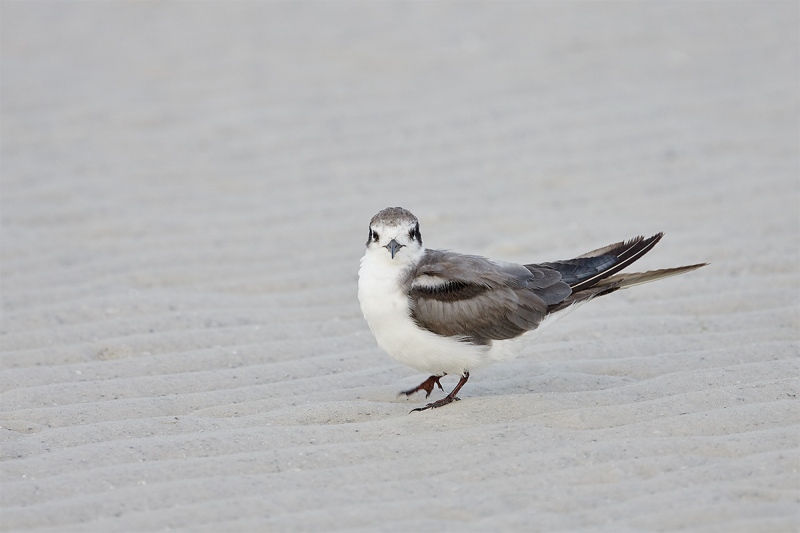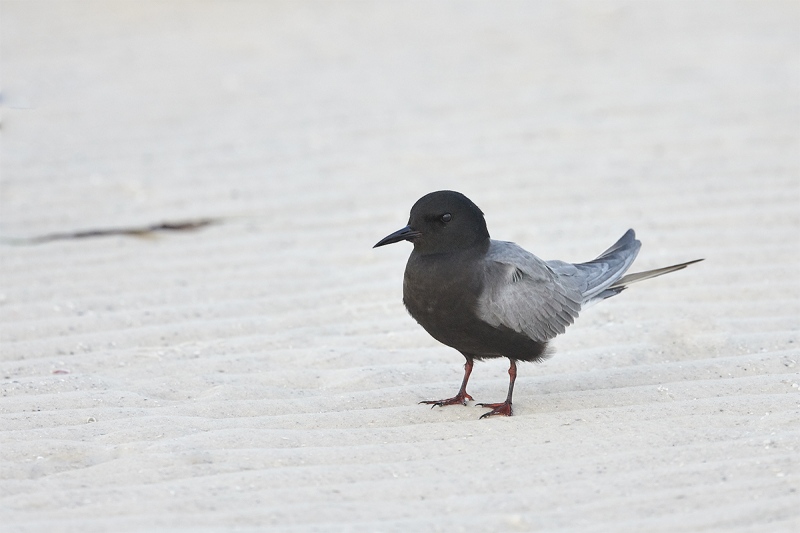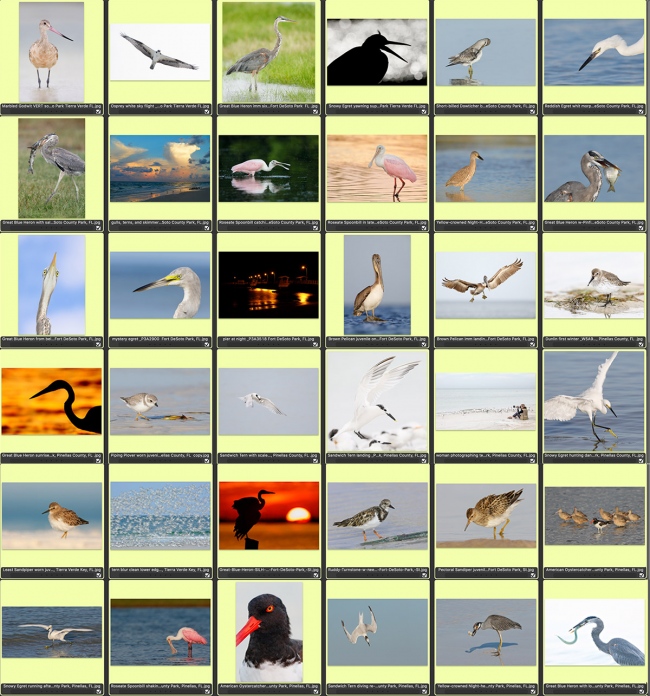What’s Up?
Inspired by friend and client Greg Gulbransen (and his great gallery), I have begun to work on a project that should have been completed at least a decade ago: a BIRDS AS ART Gallery. Do check out the After Hate sub-gallery here; Greg’s images and his writing are extraordinarily moving, and powerful.
There should be a decent chance to photograph Black Tern on the upcoming 2019 Fall Sandbar Secrets Fort DeSoto IPT. Scroll down for the complete details.
IPT News!
I learned last week that Mary van Deusen and her friend Patti Romano will be driving down from South Carolina to join UK Puffins and Gannets veteran Shonagh Adelman on the 2019 Fall Sandbar Secrets Fort DeSoto IPT at the end of this month. Then things got even better when DeSoto IPT veteran Jim Miller e-mailed letting me know that he would also be joining us. Everyone is excited. There are still two spots left on this great workshop.
IPT Updates
- The 2019 Fall Sandbar Secrets Fort DeSoto IPT/September 27-30, 2019: One-half and three FULL DAYS: $1499.00. Free Morning Session on Tuesday, October 1. Limit 6/Openings 2. Afternoon session on Friday, September 25 at 4pm, followed by three full days. We photograph till sunset on Monday, September 30
- The Return to Bosque Reduced Rate Scouting IPT. NOV 26-28, 2019 — 3 FULL DAYS: $1199.00. Limit: 8/Openings: 6. Extra Day Options: Join me for one to three extra In-the-Field Days at the end of the IPT as follows: FRI 29 NOV, SAT 30 NOV, and SUN 1 DEC for only $300.00/day.
- The 2020 San Diego 4 1/2-DAY BIRDS AS ART Instructional Photo-Tour (IPT) WED JAN 8, 2020 thru and including the morning session on SUN JAN 12: 4 1/2 days: $2099.(Limit: 8/Openings: 5)
FlexShooter Pro News
All FlexShooter Pro BigFeet are now in stock in the BAA Online Store. You can click on the chart above or here for more information.
Coming Soon
The FlexShooter Mini
Several months ago I had a FlexShooter Mini to test on both the UK Puffins and Gannets IPT and the Galapagos Photo-Cruise of a Lifetime. It is a smaller, lighter (one pound!) version of the amazing FlexShooter Pro. I used it often with both the Nikon 500 PF and the SONY 100-400 GM with great success and in a pinch, I was able to make sharper images with the Nikon 600 and the TC-E14. All with the Mini mounted on the lighter Induro GIT 204. I suggested to developer/manufacturer Csaba Karai that the Mini needed a bit more spring tension. A new batch with my suggested changes should be in stock in about two weeks.
The FlexShooter Mini with the lighter Induro GIT 204 is dead-solid-perfect for those whose intermediate telephoto or telephoto zoom is their workhorse lens for bird and nature photography. It will sell for $579 plus shipping. Folks who wish to be assured of getting one from our first shipment can order theirs by phone by calling Jim at 863-692-0906 asap. Your card will not be charged until your Mini is shipped.
FlexShooter Pro Update
We currently have only four FlexShooter Pro heads in stock here. We have all but one of the BigFeet in stock (phone orders only for now: 863-692-0906) but are sold out of the new FLN-60 BigFoot that was recently re-designed for the Nikon 600 VR. Click here to access the pretty much complete FlexShooter Pro story with videos.
Money Saving Reminder
If you need a hot photo item that is out of stock at B&H, would enjoy free overnight shipping, and would like a $50 discount on your first purchase, click here to order and enter the coupon code BIRDSASART at checkout. If you are looking to strike a deal on Canon or Nikon gear (including the big telephotos) or on a multiple item order, contact Steve Elkins via e-mail or on his cell at (479) 381-2592 (Eastern time) and be sure to mention your BIRDSASART coupon code and use it for your online order. Steve currently has several D850s in stock along with a Nikon 600mm f/4 VR. He is getting folks the hot new SONY stuff: the 200-600, the 600 f/4 GM, and the 7R iv. And the wait-list is short for the Nikon 500 P.


Gear Questions and Advice
Too many folks attending BAA IPTs and dozens of photographers whom I see in the field and on BPN, are–out of ignorance–using the wrong gear especially when it comes to tripods and more especially, tripod heads… Please know that I am always glad to answer your gear questions via e-mail. Those questions might deal with systems, camera bodies, accessories, and/or lens choices and decisions.
|
|
|
This image was created on the morning of May 6, 2019 on the DeSoto Spring Sandbar Secrets IPT. I used the handheld Nikon AF-S NIKKOR 500mm f/5.6E PF ED VR lens, the Nikon AF-S Teleconverter TC-14E III, and my souped-up Nikon D850 ISO: 1250. Matrix metering plus about 2/3 stop: 1/400 sec. at f/9 in Manual mode. Natural light AUTO WB at 6:12:29pm on a fully cloudy afternoon.. One below center Group (grp) Continous AF was active at the moment of exposure as originally framed. Nikon Focus Peaking fine-tune value: +1. See the Nikon AF Fine-tune e-Guide here. Image #1: Black Tern, likely a first-summer birdClick on the image to enjoy a larger version. |
Speaking of Black Tern …
This species breeds in inland marshes from coast to coast across the US and southern Canada. When I lived in New York, I’d see them rarely in fall at Jamaica Bay Wildlife Refuge and more recently, at Nickerson Beach. I usually see them in Florida at Fort DeSoto in the fall. Running across the two birds featured in today’s blog post in spring was a first.
The bird shown in Image #1 is most likely in first-summer plumage. Many species of gulls, terns, and shorebirds have a distinct juvenile plumage that they wear for several months after fledging. That is followed by a molt to first-winter and then to first summer plumage. They do not molt into adult breeding plumage (see Image #2) until their second or third or even fourth years. I am pretty sure that most terns — including Black Tern — reach full adulthood in their second year.
|
|
|
This image was created on the morning of May 6, 2019 on the DeSoto Spring Sandbar Secrets IPT. I used the handheld Nikon AF-S NIKKOR 500mm f/5.6E PF ED VR lens, the Nikon AF-S Teleconverter TC-14E III, and my souped-up Nikon D850 ISO: 1250. Matrix metering plus about 2/3 stop: 1/400 sec. at f/9 in Manual mode. Natural light AUTO WB at 6:12:50pm on a fully cloudy afternoon.. One below center Group (grp) Continous AF was active at the moment of exposure as originally framed. Nikon Focus Peaking fine-tune value: +1. See the Nikon AF Fine-tune e-Guide here. Image #2: Black Tern, adult breedingClick on the image to enjoy a larger version. |
Black Tern in breeding plumage
Black Tern in full breeding plumage with its black body and dark grey wings is a distinctively handsome bird. I am always excited when I find one. As today’s two images were created a mere 21 seconds apart, it is easy to figure out that they were hanging out on the sandbar together, mixed in with the royals, sandwiches, and Forster’s.
Exposure Question
The exposure settings for both of today’s images are identical: ISO 1250, 1/400 sec. at f/9. If the exposure and the histogram were perfect for Image #1, and the light was constant, what do we know for sure about Image #2? Note: if you cannot answer this question instantly, then you have some serious studying to do …
Image Clean-up Question
Would you have removed the strip of beach grass on the left side of Image #2? Why or why not?
Speaking of the 500 PF and the TC-E14 …
As noted here on many occasions, the Nikon 500 PF with the 1.4X teleconverter is a sharp, viable combination. The single negative is that as you move the selected AF point or array away from the center, AF performance suffers badly. When you get well away from the center, the rig will simply not acquire focus even in high contrast situations … And as compared to lugging around a 600mm f/4, working with the 500 PF with or without a TC is an absolute pleasure.
BIRDS AS ART
BIRDS AS ART is registered in the U.S. Patent and Trademark Office.
|
|
|
Fort DeSoto in fall is rife with tame birds. All of the images in this card were created at Fort DeSoto in either late September or very early October. I hope that you can join me there this September. Click on the composite to enjoy a larger version. |
The 2019 Fall Sandbar Secrets Fort DeSoto IPT/September 27-30, 2019: One-half and three FULL DAYS: $1499.00. Limit 6/Openings 2.
Afternoon session on Friday September 25 at 4pm. That followed by three full days. We photograph till sunset on Monday, September 30
Added: a Free Morning Session on Tuesday October 1
Fort DeSoto, located just south of St. Petersburg, FL, is a mecca for migrant shorebirds and terns in fall. There they join hundreds of egrets, herons, night-herons, and gulls that winter on the T-shaped peninsula. With luck, we may get to photograph two of Florida’s most desirable shorebird species: Marbled Godwit and Roseate Spoonbill. Black-bellied Plover and Willet are easy. Great Egret, Snowy Egret, Great Blue Heron, Tricolored Heron, and White Ibis are easy as well and we will almost surely come up with a tame Yellow-crowned Night-Heron or two along with some American Oystercatchers. We may very well get to see and photograph the amazing heron/egret hybrid that has been present for four years. We should get to do some Brown Pelican flight photography. In addition, Royal, Sandwich, Forster’s, and Caspian Terns will likely provide us with some good flight opportunities as well. Though not guaranteed, Wood Stork might well be expected. And we will be on the lookout for a migrant passerine fallout in the event of a thunderstorm or two.
On the IPT you will learn:
- 1- The basics and fine points of digital exposure; how to get the right exposure every time after making a single test exposure.
- 2- How and why to work in Manual mode (even if you’re scared of it).
- 3- How to approach free and wild birds without disturbing them.
- 4- Lots about bird behavior and how to use that knowledge to help you create better images.
- 5- To age and identify many species of shorebirds including sandpipers, plovers, dowitchers, and possibly yellowlegs.
- 6- To spot the good situations and to choose the best perspective.
- 7- To see, evaluate, and understand the light.
- 8- To design pleasing images by mastering your camera’s AF system.
- 9- And perhaps most importantly, to evaluate wind and sky conditions and understand how they affect bird photography.
- 10- How and when to access the magical sandbar safely.
- 11- More than you could ever imagine.
Morning sessions will run at least three to 3 1/2 hours, afternoon sessions 2 1/2 to 3 hours. There is never a set schedule on an IPT — we adapt to the conditions. There will be a Photoshop/image review session after lunch (included) each day. That will be followed by Instructor Nap Time. This IPT will run with only a single registrant (though that is not likely to happen). The best airport is Tampa (TPA). Once you register, you will receive an e-mail with the hotel information. Do know that it is always best if IPT folks stay in the same general area (rather than at home or at a friend’s place a good distance away).
Folks attending this IPT will be out in the field early and stay late to take advantage of sunrise and sunset colors; this is pretty much a staple on almost all BIRDS AS ART Instructional Photo-Tours. Doing so will often present unique photographic opportunities, opportunities that will be missed by those who need their beauty rest and those who need to get home for a proper dinner. I really love it when I am leaving the beach at 9:30am on a sunny morning after a great session just as a carful or two of well-rested photographers are arriving …
Payment in full is due now. Credit cards are OK for your $500 deposit. You can register by calling Jim or Jennifer during weekday business hours at 863-692-0906 with a credit card in hand. If you leave a deposit you will receive an e-mail with your balance statement and instructions for sending your balance check. If you wish to pay in full right off the bat, you can make your check out to BIRDS AS ART and send it via US mail here: BIRDS AS ART, PO BOX 7245, Indian Lake Estates, FL 33855. You will receive a confirmation e-mail with detailed instructions, and clothing and gear advice in mid-August. Please remember that we will meet early on Saturday morning. Please shoot me an e-mail if you plan to register or if you have any questions.
IPT veterans and couples or friends signing up together are urged to e-mail for discount information.
If In Doubt …
If you are in doubt about using the BAA B&H affiliate link correctly, you can always start your search by clicking here. Please note that the tracking is invisible. Web orders only. Please, however, remember to shoot me your receipt via e-mail.


Please Remember to use my Affiliate Links and to Visit the BAA Online Store 🙂
To show your appreciation for my continuing efforts here, we ask, as always, that you get in the habit of using my B&H affiliate links on the right side of the blog or Bedfords, for all of your photo and electronics purchases. Please check the availability of all photographic accessories in the New BIRDS AS ART Online Store, especially the Mongoose M3.6 tripod head, Wimberley lens plates, Delkin flash cards and accessories, and LensCoat stuff.
As always, we sell only what I have used, have tested, and can depend on. We will not sell you junk. We know what you need to make creating great images easy and fun. And please remember that I am always glad to answer your gear questions via e-mail.
I would, of course, appreciate your using our B&H affiliate links or Bedfords for all of your major gear, video, and electronic purchases. For the photographic stuff mentioned in the paragraph above, and for everything else in the new store, we, meaning BAA, would of course greatly appreciate your business. Here is a huge thank you to the many who have been using our links on a regular basis and those who will be visiting the New BIRDS AS ART Online Store as well.
Be sure to like and follow BAA on Facebook by clicking on the logo link upper right.
Typos
In all blog posts and Bulletins, feel free to e-mail or to leave a comment regarding any typos or errors. Just be right :).



















Hey Arthur, Underexposed image #2 with the same settings. The bird is much darker. What ever happened to Arthur’s finest? It was at the top where the yellow boxes are that say home,about,artist’s reference and rendering. I use to look at it time to time. There was some great stuff in there.
Thanks but I am embarrassed to say that I do not know…
I will explore some and let you know.
a
ps: a better gallery is coming soon 🙂
Hi Artie. (for Joel) You did indeed say that the light was constant in your original description above.
If the settings were the same for both images I would say that the bird in image #2 would be underexposed.
Good. Why?
a
My understanding is that if the light does not change and if your exposure for the first image is correct and if you are in manual then exposure for the second should same.
Krishna,
That is a huge and common misconception. See the info on Exposure Theory in The Art of Bird Photography, especially pages 61 and 62. Furthermore, consider this, should white subjects be exposed the same as black subjects?
I will review the principles involved here in a few days.
a
I understood it works for similar tones subjects
White and black are not similar toned 🙂
a
My thought is that the second exposure is under-exposed for the blacks in the Tern. This is supported by the sand being brighter in the processed image, indicating exposure was bumped in post.
Hey Artie, wonderful images of Black Tern. Still pondering your question… guess I have some studying to do. I read your comments regarding the 500 PF and the 1.4 teleconverter, a solution would be to carry the D500 body and use that rather than the teleconverter. Same processor and autofocus system as the D5 but a crop sensor. In effect it would provide a 1.5 teleconverter at F/5.6 with all the focus points available. Just a thought….
My guess on your exposure question would be that the dark plumage in image 2 was underexposed by using the same settings as image 1 unless there was significantly more ambient light or fill flash.
Thanks, Joel. I should have mentioned that the light was constant.
a